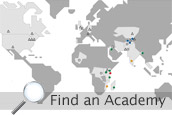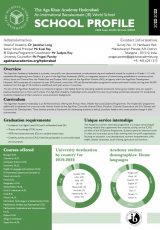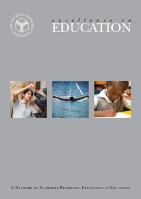Teacher exchange programme enables reflection & dialogue
Anna Palmetshofer (grade 4 form tutor) and Arzoo Parbatani (Senior School science faculty) spent two weeks at the Aga Khan Academy Mombasa on the annual teacher exchange programme between network schools. Read about their experiences below.
Arzoo writes...
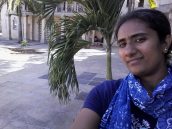
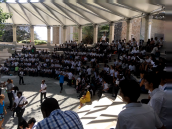
 The exchange programme was an enthralling experience both in terms of academic and cultural exchange. The teachers and staff at the Academy in Mombasa were warm and welcoming in all aspects. I taught grade 6 Science and grade 9 Chemistry. Apart from that, I also observed different classes like Theory of Knowledge and DP Biology to understand some of the different approaches to teaching and learning.
The exchange programme was an enthralling experience both in terms of academic and cultural exchange. The teachers and staff at the Academy in Mombasa were warm and welcoming in all aspects. I taught grade 6 Science and grade 9 Chemistry. Apart from that, I also observed different classes like Theory of Knowledge and DP Biology to understand some of the different approaches to teaching and learning.
A typical day would include observing lessons, team teaching and independently teaching classes, collaborating with our parallel teachers and other teachers in the department, attending department meetings and various professional development sessions. We actively took part in daily school activities such as the assemblies and morning briefings, and participated in teacher enrichment activities like friendly basketball matches.
When there was some time available in the evenings, we would just take a walk around the neighbourhoods of Mombasa. I was thrilled to visit the white sand Diani beach at the south coast of Mombasa, and Haller National Park which hosts mighty giraffes, hippos, crocodiles and other wild animals. Residing in a metropolitan city like Hyderabad, it is not every day that you can feel so close to the nature. The exchange is not really over yet, I am eagerly waiting for my partner teacher to visit Hyderabad so that we can have another opportunity to collaborate and share!”
Anna shares...
I was warned that crows would be trying to steal food from my plate. One of the men waiting the tables was equipped with a sling, a projectile weapon to scare them away. At times when he was bored, he would start spinning the brown serving tray on the tips of his fingers. Like all the other waiters, he wore black Wellington boots; I wished the community of waiters would step up and do a South African inspired gumboot dance flash mob. If only this waiter could be discovered and get a job at Cirque du Soleil! That would help tremendously in increasing his social and his financial capital.
I joined some older students for breakfast outdoors to find out about life in the 'academic castle'. The boy I talked to was from neighboring Tanzania, the ancient port of Dar Es Salam. The name alone evokes thoughts of a hectic drumming pattern, frenetic and rhythmical dancing, and is easily confused in my mind with Dharamshala, in the Indian Himalayas. Both of the students I met seemed to enjoy life at the Academy, yet neither would have earned the predicate of easygoing conversationalists. Despite a certain awkwardness I persisted, tried to be entertaining and told them about my own trails and life meanderings in India and other places in the wide world.
What was it like to walk the streets of Kenya? Footsteps resonating on the cobblestones in the old part of town. Fort Jesus! What an evocative name, one that rings like a church bell in my ear. Just another legacy of colonization by my fellow 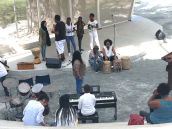
Europeans, the big adventurers and ruthless traders. However, imperialism is not an exclusively Western vice; Dar Es Salam and Zanzibar were a slave trading post established by Arab merchants. The beliefs of Westerners remain intrusive and overpowering, and Africa finally finding its own identity after the colonial trauma is the topic of one of the student`s TEDx talks, which we managed to attend at AKA Mombasa.
Let me stop here, sit down, and look at the moon for a while. The moon has waned down to a mere sickle, and only a few people are walking in the streets at this hour. There is enough time to bring back the memory of the yellow walls in the old town, and talk to an elderly lady from India. She came here many years ago, on a boat from Bombay, second class, dirt cheap, seeking new opportunities for business, and engaged in the tea trade. Does India import tea from Africa and vice versa?
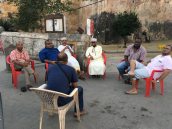 The late closing shops are proudly displaying Masai spears and shields, once used for killing lions which was a rite of passage for young Masai men. Now, talking about the Masai conjures up in my mind thoughts of the ancestral inhabitants - Australopithecus - of Kenya. Ceramics, jewelry, beads, and glass were among the artefacts traded from the far and near east. In exchange, the Swahili offered some of their own exotic goods in the form of magnificent sea shells, tortoise shells, rhinoceros horns, various type of animal skins, ivory and ambergris, that precious component of perfumes.
The late closing shops are proudly displaying Masai spears and shields, once used for killing lions which was a rite of passage for young Masai men. Now, talking about the Masai conjures up in my mind thoughts of the ancestral inhabitants - Australopithecus - of Kenya. Ceramics, jewelry, beads, and glass were among the artefacts traded from the far and near east. In exchange, the Swahili offered some of their own exotic goods in the form of magnificent sea shells, tortoise shells, rhinoceros horns, various type of animal skins, ivory and ambergris, that precious component of perfumes.

